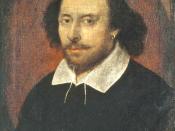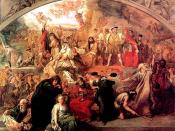The purpose of this essay is to critically analyse William Shakespeare's Sonnet #116. Throughout this essay I will be referring often to text of the poem William Shakespeare's "Sonnet 116" exploits conventional sonneteering (Kerrigan ,1986,1995:11) to speak of his perception and judgement of love. The sonnets structure, three quatrains and a couplet echoes the poets' content further emphasizing his notion that true love is constant. The tone of the poem expresses great amounts of final conviction, asserting the poets beliefs that he indeed knows what love is and what it is not. His ingenious use of metaphors and poetic features convey his realistic declaration that true love weathers all storms.
The first quatrain introduces the subject of the poem 'True Love'. The speaker informs the audience, true love is not how others see it or is it the establishments view. Love does not depend on time, or place, on beliefs, or the sex of the lovers.
Love does not change or cease just because we notice our beloved has changed nor can it be taken away by death or severed by separation. The language used in the first two lines of the poem: Let me not to the marriage of true minds/ Admit impediments... focuses our ears on the first metaphor of this sonnet 'marriage' drawing our attention to Christian marriage services by echoing The Solemnization of Marriage from "The Book of Common Prayer" (online: 2003, 10 April: 8) "that if either of you know any impediment, why ye may not be lawfully joined together in Matrimony, ye do now confess it". The ceremony is specifically designed to marry two people for all the right reasons. In most cultures it is taboo to marry a close relative, or someone of the same sex. However, Shakespeare refers to this union...


